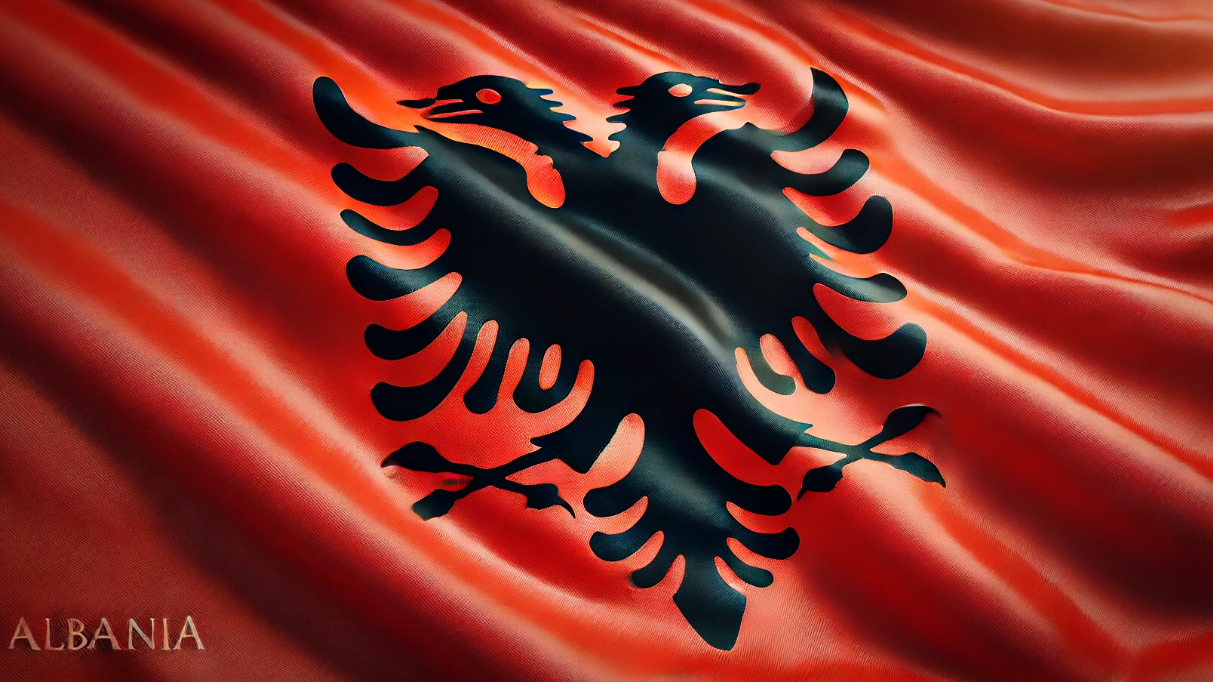The flag of Albania, known for its striking red field and black double-headed eagle, is a powerful symbol of the nation’s history, culture, and sovereignty. The current design was officially adopted on November 28, 1992, but its origins trace back much further, to the medieval period and the legacy of the national hero, Skanderbeg.
Medieval Origins
The black double-headed eagle has been a symbol associated with Albania for centuries, stemming from the noble family of Kastrioti. Gjergj Kastrioti, known as Skanderbeg, was a prominent Albanian leader in the 15th century who resisted Ottoman rule. He used a similar flag during his military campaigns, which became a symbol of Albanian resistance and national pride.
20th Century Developments
During the late 19th and early 20th centuries, as Albanian nationalism grew, the flag became a rallying symbol for independence movements. Albania declared its independence from the Ottoman Empire on November 28, 1912, under a flag bearing the same double-headed eagle design. The red and black colors were retained to represent bravery, strength, and the bloodshed in the struggle for freedom.
Throughout the 20th century, Albania underwent various political changes, from a monarchy to a communist state, and finally to a democratic republic. Each regime made minor alterations to the flag, such as adding a star during the communist era, but the essential elements of the red field and black eagle remained constant.
Symbolism and Meaning

The Albanian flag is rich with symbolism. The red background represents bravery, strength, and valor, while also signifying the blood shed by those who fought for the country’s independence. The black double-headed eagle, a heraldic symbol, signifies the sovereign state of Albania and its historical legacy.
The Double-Headed Eagle
The double-headed eagle is an ancient symbol that dates back to the Byzantine Empire and even earlier to the Hittites. It symbolizes the unity of church and state, as well as vigilance and dominion over both East and West. For Albanians, it embodies national identity and the resilience of the Albanian people.
The Flag in Modern Albania
Today, the Albanian flag is a prominent national symbol displayed at government buildings, public events, and homes. It is also flown during significant national holidays, such as Independence Day on November 28th and Flag Day, which commemorates the adoption of the flag. The flag is a source of immense pride for Albanians, both in the country and in the diaspora.
Conclusion
The flag of Albania, with its red field and black double-headed eagle, is more than just a national emblem. It is a representation of Albania’s rich history, its struggles for independence, and the enduring spirit of its people. From the time of Skanderbeg to the present day, the flag has been a steadfast symbol of Albanian identity and pride, reflecting the nation’s past and aspirations for the future.
References
- History of Albania – Encyclopaedia Britannica: https://www.britannica.com/place/Albania
- Skanderbeg and the Albanian Resistance – History: https://www.history.com/topics/european-history/skanderbeg
- Albanian Independence – History Today: https://www.historytoday.com/archive/months-past/albanian-independence
- Albanian Flag – CRW Flags: https://www.crwflags.com/fotw/flags/al.html
- Symbolism of the Albanian Flag – World Atlas: https://www.worldatlas.com/flags/albania
- Double-Headed Eagle – Symbol Dictionary: https://www.symbols.com/symbol/double-headed-eagle
- National Holidays in Albania – Office Holidays: https://www.officeholidays.com/countries/albania
- Albanian Flag History and Meaning – Flag Heritage Foundation: https://www.flagheritagefoundation.org/albanian-flag-history-and-meaning
